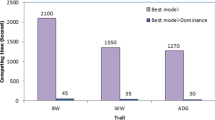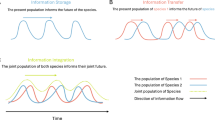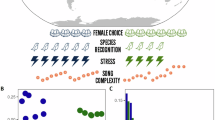Abstract
Strong directional, and to some degree stabilizing, selection usually erodes only additive genetic variance while not affecting dominance variance. Consequently, traits closely associated with fitness should exhibit high levels of dominance variance. In this study we compile a large number of estimates of dominance variance to determine if traits that are subject to strong selection and/or are closely associated with fitness have higher levels of dominance variance than traits less subject to selection pressure. Estimates were taken from the literature for both wild and domestic species and each group was treated separately. Traits closely associated with fitness (life history) had significantly higher dominance components than did traits more distantly related to fitness (morphology) for wild species. No significant differences were found between life history and morphological traits for domestic species. Traits that were known to have been subject to intense directional selection (morphological traits for domestic species) had significantly higher dominance estimates than did traits that were assumed not to have been subject to strong selection (morphological traits for wild outbred species). The results are discussed with respect to the maintenance of heritable variation and the bias introduced in the calculation of the full-sib heritability estimate by high levels of dominance variance.
Similar content being viewed by others
Article PDF
References
Arnold, S J. 1990. Inheritance and the evolution of behavioral ontogenies. In: Hahn, M. E., Hewitt, J. K., Henderson, N. D. and Benno, R. H. (eds) Developmental Behavior Genetics: Neural, Biometrical, and Evolutionary Approaches, pp. 167–189. Oxford University Press, New York.
Arnold, S J. 1994. Multivariate inheritance and evolution: a review of concepts. In: Boake, C. R. B. (ed.) Quanti- tative Genetic Analysis of the Evolution of Behavior, pp. 17–48. University Of Chicago Press, Chicago.
Barton, N H, and Charlesworth, B. 1984. Genetic revolutions, founder events and speciation. Ann Rev Ecol Syst, 15, 133–164.
Becker, W A. 1992. Manual of Quantitative Genetics, 5th edn. Academic Enterprises, Washington.
Breese, E L, and Mather, K. 1960. The organization of polygenic activity within a chromosome in Drosophila. II. Viability. Heredity, 14, 375–399.
Brodie, E D, and Garland, T. Jr. 1994. Quantitative genetics of snake populations. In: Seigel, R. A. and Collins, J. T. (eds) Snakes: Ecology and Behavior, pp. 315–362. Mcgraw-Hill, New York.
Bryant, E H, McCommass, S A, and Combs, L M. 1986. The effect of an experimental bottleneck upon quantitative genetic variation in the housefly. Genetics, 114, 1191–1211.
Bryant, E H, and Meffert, L M. 1991. The effects of bottlenecks on genetic variation, fitness, and quantitative traits in the housefly. In: Dudley, E. C. (ed.) The Unity of Evolutionary Biology, Proceedings of the Fourth International Congress of Systematics and Evolutionary Biology, pp. 591–601. Dioscorides Press, Portland, OR.
Bulmer, M G. 1985. The Mathematical Theory of Quantitative Genetics. Clarendon Press, Oxford.
Carson, H L. 1990. Increased genetic variance after a population bottleneck. Trends Ecol Evol, 5, 228–230.
Carson, H L, and Wisotzky, R G. 1989. Increase in genetic variance following a population bottleneck. Am Nat, 134, 668–673.
Charlesworth, B. 1979. Evidence against Fisher's theory of dominance. Nature, 278, 848–849.
Charlesworth, B. 1987. The Heritability of Fitness. In: Bradbury, J. W. and Andersson, M. B. (eds) Sexual Selection: Testing the Alternatives, pp. 21–40. Dahlem Workshop on Sexual Selection. John Wiley and Sons, Chichester.
Charlesworth, D, and Charlesworth, B. 1987. Inbreeding depression and its evolutionary consequences. Ann Rev Ecol Syst, 18, 237–268.
Cockerham, C C, and Tachida, H. 1988. Permanency of response to selection for quantitative characters in finite populations. Proc Natl Acad Sci USA, 85, 1563–1565.
Crow, J F, and Kimura, M. 1970. An Introduction to Population Genetics Theory. Harper and Row, New York.
Crow, J F, and Simmons, M J. 1983. The mutation load in Drosophila. In: Ashburner, M., Carson, H. L. and Thompson, J. N., Jr. (eds) The Genetics and Biology of Drosophila, 3c, pp. 2–35. Academic Press, London.
Dobzhansky, Th. 1952. Nature and origin of heterosis. In: Gowen, J. W. (ed.) Heterosis, pp. 218–223. Iowa State College Press, Ames, IA.
Dohm, M R, and Garland, T. Jr. 1993. Quantitative genetics of snake counts in the garter snake Thamnophis sirtalis. Copeia, 4, 987–1002.
Enfield, F D. 1980. Long-term effects of selection: the limits to response. Proceedings of the Symposium on Selection Experiments in Laboratory and Domestic Animals, pp. 69–86. Commonwealth Agricultural Bureau, Slough.
Falconer, D S. 1981. Introduction to Quantitative Genetics, 2nd edn. Longman, London.
Falconer, D S. 1989. Introduction to Quantitative Genetics, 3rd edn. John Wiley and Sons, New York.
Felsenstein, J. 1965. The effect of linkage on directional selection. Genetics, 52, 349–363.
Fisher, R A. 1928. The possible modification of the response of wild type to recurrent mutations. Am Nat, 62, 115–126.
Fisher, R A. 1930. The Genetical Theory of Natural Selection. Clarendon Press, Oxford.
Fisher, R A. 1958. The Genetical Theory of Natural Selection, 2nd edn. Dover Publications, New York.
Futuyma, D J. 1986. Evolutionary Biology, 2nd edn. Sin-auer Associates, Sunderland, MA.
Garland, T. Jr. 1994. Quantitative genetics of locomotor behavior and physiology in a garter snake. In: Boake, C. R. B. (ed.) Quantitative Genetic Studies of Behavioral Evolution, pp. 251–277. University of Chicago Press, Chicago.
Garland, T. Jr, and Bennett, A F. 1990. Quantitative genetics of maximal oxygen consumption in a garter snake. Am J Physiol, 259, R986–R992.
Garland, T. Jr. Bennett, A F, and Daniels, C B. 1990. Heritability of locomotor performance and its correlates in a natural population. Experientia, 46, 530–533.
Gomez-Raya, L, and Burnside, E B. 1990. The effect of repeated cycles of selection on genetic variance, heritability, and response. Theor Appl Genet, 79, 568–574.
Goodnight, C J. 1987. On the effect of founder events on epistatic genetic variance. Evolution, 41, 80–91.
Haldane, J B S. 1932. The Causes of Evolution. Longmans, Green&CO., New York.
Hayashi, T, and Ukai, Y. 1994. Change in genetic variance under selection in a self-fertilizing population. Genetics, 136, 693–704.
Hegmann, J, and Dingle, H. 1982. Phenotypic and geno-typic covariance structure in milkweed bug life history traits. In: Dingle, H. and Hegmann, J. (eds) Evolution and Genetics of Life Histories, pp. 177–186. Springer, New York.
Kacser, H, and Burns, J A. 1981. The molecular basis of dominance. Genetics, 97, 639–666.
Kaufman, P K, Enfield, F D, and Comstock, R E. 1977. Stabilizing selection for pupa weight in Tribolium casta-neum. Genetics, 87, 327–341.
Kearsey, M J, and Kojima, K. 1967. The genetic architecture of body weight and egg hatchability in Drosophila melanogaster. Genetics, 56, 23–37.
Kendall, M, and Stuart, A. 1979. The Advanced Theory of Statistics II Inference and Relationship, 4th edn. Macmillan, New York.
Lacy, R C. 1987. Loss of genetic diversity from managed populations: interacting effects of drift, mutation, immigration, selection, and population subdivision. Conserv Biol, 1, 143–158.
Lande, R. 1980. Genetic variation and phenotypic evolution during allopatric speciation. Am Nat, 116, 463–479.
Lande, R. 1988. Quantitative genetics and evolutionary theory. In: Weir, B., Eisen, E., Goodman, M. and Nam-koong, G. (eds.) Proceedings of the Second International Conference on Quantitative Genetics, pp. 71–84. Sinauer Ass., Sunderland, MA.
Lee, B T O, and Parsons, P A. 1968. Selection, prediction and response. Biol Rev, 43, 139–174.
Lerner, I M. 1954. Genetic Homeostasis. Oliver&Boyd, Edinburgh.
Lopez-Fanjul, C, and Villaverde, A. 1989. Inbreeding increases genetic variance for viability in Drosophila melanogaster. Evolution, 43, 1800–1804.
Lynch, C B. 1994. Evolutionary inferences from genetic analysis of cold adaptation in laboratory and wild populations of the house mouse, Mus domesticus. In: Boake, C. R. B. (ed.) Quantitative Genetic Studies of Behavioral Evolution. University of Chicago Press, Chicago.
Lynch, C, and Sulzbach, D. 1984. Quantitative genetic analysis of temperature regulation in Mus musculus. II. Diallel analysis of individual traits. Evolution, 38, 527–540.
Mather, K. 1979. Historical overview: quantitative variation and polygenic systems. In: Thompson, J. N., Jr. and Thoday, J. M. (eds) Quantitative Genetic Variation, pp. 5–34. Academic Press, New York.
Mousseau, T A, and Roff, D A. 1987. Natural selection and the heritability of fitness components. Heredity, 59, 181–197.
Nei, M, Maruyama, T, and Chakraborty, R. 1975. The bottleneck effect and genetic variability in populations. Evolution, 29, 1–10.
Partridge, L. 1994. Genetic and non-genetic approaches to questions about sexual selection. In: Boake, C. R. B. (ed.) Quantitative Genetic Studies of Behavioral Evolution, pp. 126–141. University of Chicago Press, Chicago
Price, T, and Schlüter, D. 1991. On the low heritability of life-history traits. Evolution, 45, 853–861.
Robertson, A. 1952. The effect of inbreeding on variation due to recessive genes. Genetics, 37, 189–207.
Roff, D A. 1994. Evolution of dimorphic traits: effect of directional selection on heritability. Heredity, 72, 35–41.
Roff, D A, and Mousseau, T A. 1987. Quantitative genetics and fitness: lessons from Drosophila. Heredity, 58, 103–118.
Rose, M R, Service, P M, and Hutchinson, E W. 1987. Three approaches to trade-offs in life history evolution. In: Loeschcke, V. (ed.) Genetic Constraints on Adaptive Evolution, pp. 91–105. Springer, Berlin.
Schwartz, J M, and Herzog, H A. 1994. Estimates of heritability of antipredator behaviour in three garter snake species (Thamnophis butleri, T. melanogaster, T. sirtalis) in nature. Behav Genet, (in press).
Simmons, M J, and Crow, J F. 1977. Mutations affecting fitness in Drosophila populations. Ann Rev Genet, 11, 49–78.
Sokal, R R, and Rohlf, F J. 1981. Biometry, 2nd edn. Freeman, San Francisco.
Tachida, H, and Cockerham, C C. 1989. Effects of identity disequilibrium and linkage on quantitative variation in finite populations. Genet Res, 53, 63–70.
Turelli, M. 1988. Phenotypic evolution, constant covariances and the maintenance of additive variance. Evolution, 42, 1342–1347.
Villanueva, B, and Kennedy, B W. 1990. Effect of selection on genetic parameters of correlated traits. Theor Appl Genet, 80, 746–752.
Wilkinson, L. 1990. SYSTAT: The System for Statistics. SYSTAT, Evanston, IL.
Willis, J H, Coyne, J A, and Kirkpatrick, K. 1991. Can one predict the evolution of quantitative characters without genetics? Evolution, 45, 441–444.
Willis, J H, and Orr, H A. 1993. Increased heritable variation following population bottlenecks: the role of dominance. Evolution, 47, 949–957.
Wright, S. 1929. Fisher's theory of dominance. Am Nat, 63, 274–279.
Author information
Authors and Affiliations
Rights and permissions
About this article
Cite this article
Crnokrak, P., Roff, D. Dominance variance: associations with selection and fitness. Heredity 75, 530–540 (1995). https://doi.org/10.1038/hdy.1995.169
Received:
Issue date:
DOI: https://doi.org/10.1038/hdy.1995.169
Keywords
This article is cited by
-
Heritability and variance components of seed size in wild species: influences of breeding design and the number of genotypes tested
Heredity (2023)
-
Tests for associations between sexual dimorphism and patterns of quantitative genetic variation in the water strider, Aquarius remigis
Heredity (2023)
-
The sources of variation for individual prey-to-predator size ratios
Heredity (2021)
-
Rapid sex-specific evolution of age at maturity is shaped by genetic architecture in Atlantic salmon
Nature Ecology & Evolution (2018)
-
Effects of genetic distance on heterosis in a Drosophila melanogaster model system
Genetica (2018)



